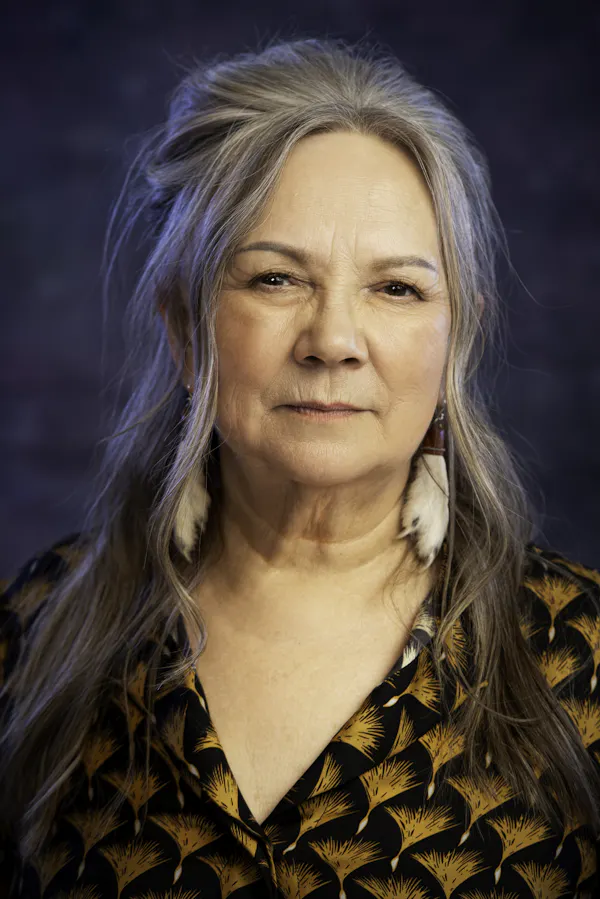
Mari Boine
- 1956
- Musician
- Karasjok
Imagine the ice and snow of the Arctic landscape, the bitter cold of the Northern wind, the hint of compelling blue under a crystallised lake. Close your eyes. Then listen. Really listen. You’ll feel a voice before you even hear it. It’s like none other. It’s a voice that brings the landscape alive with a mesmerising purity; a voice that represents a thousand years of ancestral connection to an unyielding frozen space.
This is Mari Boine.
An artist whose music is inspired by and infused with her Sámi roots. A woman who knows who she is, where she’s come from and what she stands for. A music icon who has inspired indigenous artists and has touched people’s minds, souls and hearts the world over.

Get to know Mari Boine through this filmportrait.
Over 30 years have passed since Mari Boine swept music lovers around the globe off their feet. First with her astonishing solo album Gula Gula which was released internationally on Peter Gabriel’s famous RealWorld label, then, in the same year, with her participation together with Roger Ludvigsen in the breath-taking video clip One World One Voice produced by Rupert Hines.
With her unique voice, Mari and multi-instrumentalist, composer and producer Ludvigsen, created a sound universe of her own. Undoubtly, he made a great contribution to Maris’ first 15 years of career when they toured all over the world. Till today, Ludvigsen has continued to be an important creative force for the new Sámi wave and generation of artists. Ludvigsen was in the 1970s a member of Ivnniguin, the first rock band to sing in Sami language.
For Gula Gula which celebrated its 30th year anniversary in 2020, Mari received the first of her four Spellemannsprisen (commonly referred to as Norway’s Grammy Award). She also received the Nordic Council Music Prize and the Arts Council Norway Honorary Award. In 2009, Mari was awarded with the Knight of 1st class in the order of St. Olav for her versatile artistic work by the Royal Court, the highest honor a civil person in Norway could receive.
From the start, Mari has been one of the most outspoken and important representatives of the Sámi culture. As an artist and activist, she has worked tirelessly for the recognition and preservation of the indigenous Sámi culture, thus inspiring younger generations to be proud of their unique roots. Even though Mari draws heavily on her musical heritage (Christian Laestadian hymn singing, Sámi joik chants, and Norwegian folk music), she masterfully blends these influences with modern musical elements from jazz, rock, and pop.
Today Mari Boine is revered as a truly unique artist whose trajectory led her to release more than a dozen highly-acclaimed solo albums and collaborate with stellar Norwegian jazz musicians like Jan Garbarek and Bugge Wesseltoft.
In the past years, Mari Boine has also collaborated with the sound wizard, trumpeter and flutist Ole J. Myklebust. In addition to his work as a soloist, Ole has contributed as a co-produced for Mari Boine in several releases.

Mari Boine has been working steadly for a few years now with an all star band. She is currently in studio working on her new album, produced by Svein Schultz, a long time “partner in crime”. With Schultz (bass, composer and producer), their collaborations range from live performances such as the Nobel Peace Prize Concert in Oslo, Norway, 2002, to recordings and film soundtracks. In 2008, they composed the music for the movie „Kautokeino Rebellion“. Directed by Nils Gaup, the film is based on the true story of the Kautokeino riots in Norway. Ten years later, in 2018, together with Harry de Wit, they co-wrote the music of the movie The Miracle of the Little Prince.
Another long time associate of Mari Boine is Georg Buljo (guitar) who has worked with her since 2004, being part of many relevant works and tours by the artist. Together, they composed one of Mari Boine’s classic songs, Vuoi Vuoi Me. Gunnar Augland (drums), another important member of the group, has also being touring intensively with Mari Boine in Europe, countries like South Africa, China, New Zealand, Australia and throughout South America. His shamanistic beats also helped to define a trademark in the sound of Mari Boine.